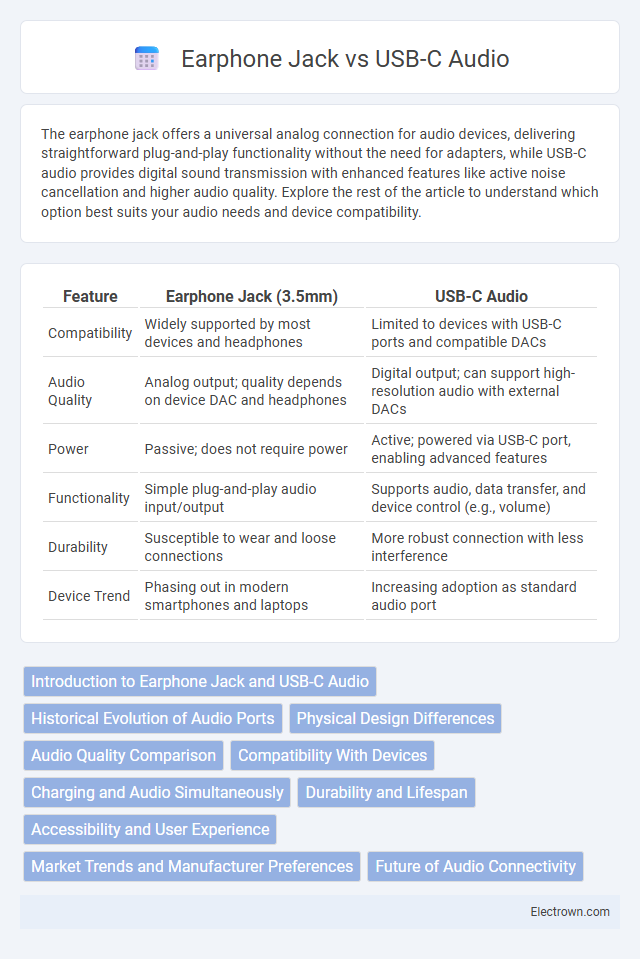The earphone jack offers a universal analog connection for audio devices, delivering straightforward plug-and-play functionality without the need for adapters, while USB-C audio provides digital sound transmission with enhanced features like active noise cancellation and higher audio quality. Explore the rest of the article to understand which option best suits your audio needs and device compatibility.
Table of Comparison
| Feature | Earphone Jack (3.5mm) | USB-C Audio |
|---|---|---|
| Compatibility | Widely supported by most devices and headphones | Limited to devices with USB-C ports and compatible DACs |
| Audio Quality | Analog output; quality depends on device DAC and headphones | Digital output; can support high-resolution audio with external DACs |
| Power | Passive; does not require power | Active; powered via USB-C port, enabling advanced features |
| Functionality | Simple plug-and-play audio input/output | Supports audio, data transfer, and device control (e.g., volume) |
| Durability | Susceptible to wear and loose connections | More robust connection with less interference |
| Device Trend | Phasing out in modern smartphones and laptops | Increasing adoption as standard audio port |
Introduction to Earphone Jack and USB-C Audio
The earphone jack, typically a 3.5mm audio port, has been the standard for analog audio connections in smartphones, headphones, and other audio devices for decades, offering wide compatibility and ease of use. USB-C audio utilizes digital signals transmitted through the USB Type-C port, supporting high-resolution audio, enhanced sound quality, and integration with modern smartphones lacking dedicated headphone jacks. This transition from analog earphone jacks to USB-C audio reflects advancements in audio technology, device design, and consumer preferences for multifunctional connectivity.
Historical Evolution of Audio Ports
Audio ports have evolved significantly from the traditional 3.5mm earphone jack, introduced in the late 19th century, to the modern USB-C audio interface that supports digital signal transmission and enhanced audio quality. The 3.5mm jack, widely adopted for analog audio since the 1960s, remained a standard due to its simplicity and compatibility across devices, while USB-C emerged with smartphones and laptops, enabling multifunctional connectivity for power, data, and audio. Your choice between earphone jack and USB-C audio reflects this evolution, balancing legacy support and advanced technology for optimal sound performance.
Physical Design Differences
The earphone jack features a 3.5mm analog port designed for straightforward audio transmission, allowing compatibility with a wide range of traditional headphones. USB-C audio ports utilize a digital interface that supports audio output, power delivery, and data transfer through a single connector, enabling advanced features like noise cancellation and higher audio fidelity. The physical design of the USB-C port is more compact and reversible compared to the earphone jack, supporting modern slim smartphone models with multifunctional capabilities.
Audio Quality Comparison
Earphone jack audio delivers analog sound with minimal latency and compatibility across most devices, but USB-C audio transmits digital signals, allowing for higher resolution sound and advanced features like noise cancellation and equalization through supported DACs. USB-C audio often provides superior audio fidelity due to reduced interference and enhanced signal processing capabilities when paired with high-quality digital-to-analog converters. Your choice influences audio quality, as USB-C can offer clearer, richer sound, especially with devices lacking traditional headphone jacks.
Compatibility With Devices
Earphone jack compatibility remains widespread with older and budget devices, allowing seamless connection to most smartphones, laptops, and audio players without adapters. USB-C audio is increasingly standard on newer smartphones and laptops, offering digital sound quality but requiring specific USB-C headphones or adapters for traditional 3.5mm earphones. Your choice impacts ease of use and device compatibility, especially if you frequently switch between older and modern gadgets.
Charging and Audio Simultaneously
The USB-C audio connection allows users to charge their devices and listen to music simultaneously through a single port, providing enhanced convenience compared to the traditional earphone jack, which requires separate ports for charging and audio output. Many modern smartphones have eliminated the headphone jack, making USB-C headphones or adapters essential for dual functionality. USB-C technology supports higher audio quality and digital signal processing, improving the listening experience while maintaining device power.
Durability and Lifespan
USB-C audio connectors generally offer enhanced durability compared to traditional earphone jacks due to their solid-state design and resistance to physical wear. Earphone jacks, often made from metal and featuring spring-loaded pins, are prone to deformation and loosening after extensive use, reducing longevity. USB-C ports also support digital audio transmission, minimizing signal degradation and extending overall lifespan by reducing mechanical stress during frequent plug and unplug cycles.
Accessibility and User Experience
Earphone jacks provide universal accessibility, compatible with a wide range of audio devices without requiring adapters, enhancing user convenience. USB-C audio offers digital sound quality with features like noise cancellation and power efficiency but often demands specific headphones or adapters, which may limit ease of use. The user experience of earphone jacks centers on simplicity and broad compatibility, while USB-C prioritizes advanced audio performance and feature integration.
Market Trends and Manufacturer Preferences
Market trends indicate a gradual decline in the inclusion of traditional earphone jacks as manufacturers increasingly adopt USB-C audio ports for their versatility and compatibility with modern devices. Major smartphone brands like Samsung and Google prioritize USB-C audio due to its support for high-resolution audio and integrated power delivery, aligning with consumer demand for multifunctional connectors. Despite this shift, niche markets and budget devices still retain the earphone jack, reflecting a balance between legacy support and advancing audio technology standards.
Future of Audio Connectivity
The future of audio connectivity is rapidly shifting from traditional earphone jacks to USB-C audio interfaces, driven by the increasing adoption of digital audio technology and device miniaturization. USB-C supports high-resolution audio transmission, power delivery, and data transfer in a single port, enabling more versatile and compact device designs without compromising sound quality. As manufacturers prioritize slim form factors and enhanced functionality, USB-C is becoming the standard, potentially rendering the 3.5mm headphone jack obsolete in upcoming smartphone and laptop models.
Earphone Jack vs USB-C Audio Infographic

 electrown.com
electrown.com